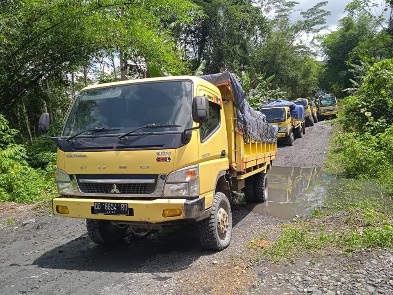News
Jayawijaya to construct weighbridge for Jayapura-Wamena route
WINDONESIA October 13, 2025 Trucks going through the Jayapura-Wamena section of the Trans Papua Road, which is still undergoing construciton. (Cenderawasih Pos/Denny)
Trucks going through the Jayapura-Wamena section of the Trans Papua Road, which is still undergoing construciton. (Cenderawasih Pos/Denny)
The Jayawijaya Regency Transportation Office has planned weighbridge on the Jayapura-Wamena section of the Trans Papua Road in Wadangku District, Jayawijaya Regency, Highland Papua Province. The weighbridge will be used as the basis for collecting fees on every vehicle entering Wamena District, Jayawijaya Regency from Jayapura Regency as part of Jayawijaya Regency's locally-generated revenue (PAD).
Jayawijaya Regency Transportation Office Head Yudha D. Daby stated that the weighbridge construction on the Jayapura-Wamena route is currently in the planning stages and is expected to be completed this year.
"We have already processed the supporting documents for the planned weighbridge construction in the Wadangku area, on the border between the regencies Jayawijaya and Yalimo which is also part of the Wamena-Jayapura [section of the] Trans-[Papua] Road," he said on Sep. 13, 2025, in Wamena District.
According to Daby, the weighbridge construction plan has received support from Jayawijaya Regent Atenius Murib and Deputy Regent Ronny Elopere, as this program would generate PAD for the local government from fees collected from every vehicle entering Jayawijaya Regency.
"We hope that if all goes well, the construction process can begin soon," he added.
Daby explained that weighbridges has previously not been built in Jayawijaya Regency, despite the high volume of land vehicle traffic from Jayapura Regency to Wamena District and vice versa. The vehicles involved sometimes carry loads that exceed the road's capacity.He emphasized that the weighbridge will allow for monitoring of freight vehicles to prevent damage to road infrastructure and maintain traffic safety.
"Once this weighbridge is built, we will be strict with vehicles used on the Jayapura-Wamena route or vice versa, and they must comply with procedures," he explained.
Daby elaborated that the weighbridge will also measure the load capacity of a vehicle and ensure it is not exceeding its capacity, ensuring driver safety.
"Vehicles must conform to factory settings and must not be modified in a way that violates applicable regulations," he concluded.

